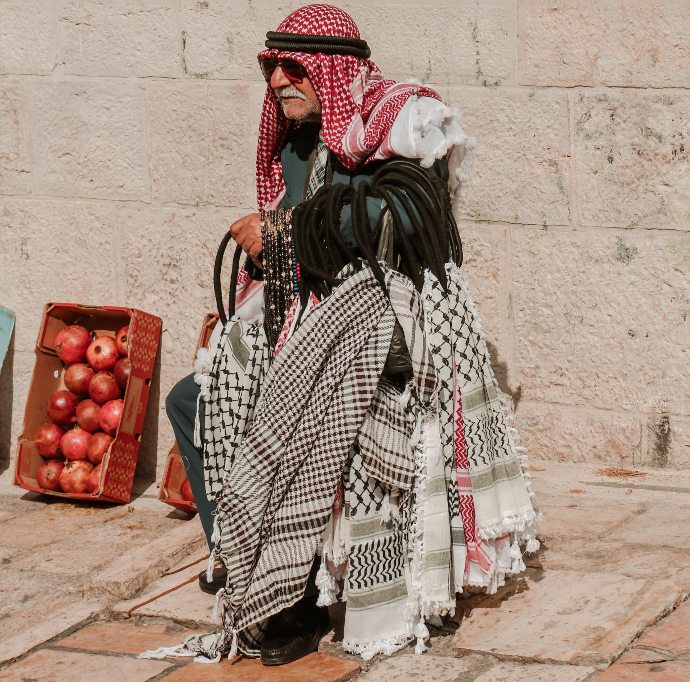In this article, we delve into the origins of these iconic garments, explore their various styles and patterns, and shed light on their importance in different regions of the world.
Join us on this enlightening journey as we unravel the intricacies of these timeless accessories.

Contents
Origins and Cultural Significance
The Keffiyeh
The keffiyeh, often referred to as a symbol of the Middle East, traces its roots back to ancient Mesopotamia. Initially worn by Bedouin tribes to protect against the harsh desert climate, it soon became an integral part of Arab culture.
The traditional keffiyeh is made from cotton, featuring a distinctive checkered pattern and a fringed edge. Its design served a practical purpose, shielding individuals from the scorching sun and blowing sand.
The Shemagh
Similar to the keffiyeh, the shemagh is a versatile headscarf primarily worn in Arab countries and the surrounding regions. While it shares similarities with the keffiyeh, the shemagh is typically larger in size and may have varying patterns, including solid colors, stripes, or more intricate designs.
Originally used as protection against desert elements, the shemagh has evolved into a fashionable accessory worn by individuals worldwide.
Read: Best Quality Shemagh
The Ghutra
The ghutra, also known as a kufiya or headscarf, is predominantly worn in the Gulf countries. Made from lightweight cotton or wool, the ghutra is traditionally white in color. Its simplicity in design signifies modesty and purity.
In some regions, the ghutra is worn beneath an agal, a circular cord used to secure the headscarf in place. The ghutra holds immense cultural significance, reflecting the heritage and traditions of the Arabian Peninsula.
Style and Variations

Keffiyeh Styles
The keffiyeh comes in various styles, each with its unique characteristics. The most well-known style is the black and white checkered pattern, commonly associated with Palestinian culture.
However, other regions feature distinct designs, such as the red and white keffiyeh of Jordan or the all-white version found in some Gulf countries.
These variations allow individuals to showcase their regional pride and cultural affiliations.
Shemagh Patterns
The shemagh offers a wide range of patterns and colors, enabling wearers to express their personal style. It can be worn as a neck scarf, head covering, or even fashioned into a face mask for protection against dust or sandstorms.
Popular shemagh patterns include classic black and white, earthy tones, and vibrant combinations. The versatility of the shemagh makes it a fashionable accessory suitable for both casual and formal occasions.
Ghutra Designs
While the ghutra is traditionally white, there are variations in design, embroidery, and border patterns. In some Gulf countries, the ghutra may have an intricately embroidered edge, adding a touch of elegance to its simplicity.
These unique embellishments reflect the cultural diversity and individual preferences within the region.
The ghutra’s versatility allows for different styling options, from a simple wrap to more elaborate draping techniques.
Global Appeal and Modern Usage
Fashion Forward
In recent years, the keffiyeh, shemagh, and ghutra have gained popularity beyond their cultural origins. Fashion enthusiasts worldwide have embraced these accessories for their style and versatility.
Designers have incorporated them into modern collections, showcasing their adaptability and timelessness.
From runway shows to street fashion, these headscarves have become a symbol of cultural appreciation and global fashion trends.
Practical Applications
Beyond their fashionable appeal, the keffiyeh, shemagh, and ghutra serve practical purposes in various situations.
Outdoor enthusiasts, hikers, and travelers recognize their value as protective gear against the elements.
The lightweight yet durable fabric shields against sunburn, dust, and wind, making them essential companions for adventurers seeking both style and functionality.
Conclusion
In conclusion, the keffiyeh, shemagh, and ghutra exemplify the rich cultural heritage of the Middle East and its surrounding regions. Their timeless designs, practical uses, and global appeal have solidified their status as iconic accessories.
Whether worn as a fashion statement or as a practical garment, these headscarves transcend boundaries and unite individuals through their shared appreciation for culture, tradition, and style.
Remember, by understanding and embracing the fascinating history and cultural significance of the keffiyeh, shemagh, and ghutra, we can honor the heritage they represent while celebrating their universal appeal in the modern world.
